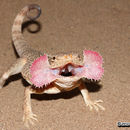Distribution
provided by ReptileDB
Continent: Africa Asia Europe
Distribution: Soviet Union, Russia (from NW coast of Caspian Sea eastward to E Kazakhstan, Dagestan, Astrakhan Oblast and Volgograd Oblast), Turkmenistan,
SE Europe, W Asia, Eritrea ? (P. isseli) , Ethiopia ? (P. isseli),
W China (N Xinjiang), Mongolia
Subspecies including synonyms:
albolineatus: China (N Xinjiang);
Type locality: 45 km south of Tacheng Co., Xinjiang Uygur Autonomous Region, China.
acutirostris: only known from its type locality (fide WERMUTH 1967);
Type locality: Dschyn-Cho south of Ebi-Nor and in Chuldscha.
alpheraki: Kazakhstan (Ili River Hollow), China
arcellazzii: C Asia (Dsungarei);
Type locality: Gaschun, in der Nähe von Gutschen in der Dschungarei.
grumgrzimailoi: W China (Xinjiang); Type locality (restricted by lectotype designation). Gutschen [= Qitai County, Xinjiang Uygur Autonomous Region, China].
kushakewitschi: valley of lake Alu-kulj north of the Lepsa river, adjacent Dsungarei.
Type locality: Kreis von Sergiopo (fide WERMUTH 1967).
melanurus: Sibiria, Russia, E Kazakhstan;
Type locality: in Sibiria australi, versus Altaicos montes.
moltschanowi: Kazakhstan, Uzbekistan;
Type locality: mouth of the Amudarya River. Gebirge Bel Tau, Wüste Amu-Daria (fide WERMUTH 1967).
salenskyi: C Asia (south of the Altai Mountains, north of Tien-schan), Kazakhstan;
Type locality: am Fluss Urungu, am Uljungur und im Bulun-Tschi am Uljungur (fide WERMUTH 1967).
salsatus: Turkmenistan;
Type locality: North Turkmeniya, salt hollow Kazakhlyshor between sands Kumsebshen and the chink of Ustjurt (40º17' N, 55º46' E)
Type locality: Ural River Valley, North Kazakhstan (in deserto Uralensi = area of the lower Ural River fide WERMUTH 1967). Restricted by neotype designation to vicinity of Atyrau (Gurjev), approximately 47o 06' N, 51o 54' E, Atyrau Province, north-western Kazakhstan by BARABANOV & ANANJEVA 2007.
Distribution
provided by ReptileDB
Continent: Asia
Distribution: China (Nei Mongol = Inner Mongolia), Ningxia, Gansu, Qinghai)
affinis: China (Inner Mongolia: Ala-Shan, Ordos deserts);
Type locality: in provincia Chinensi, Ordos dicta, nec non in deserto Alaschanico.
birulai: China (Inner Mongolia: southern Ala-Shan desert);
Type locality: südliches Alashan an der Grenze von Kansu und längs des Flusses Tangar, östliches Nan-shan (fide WERMUTH 1967).
elegans: China (Inner Mongolia, NE Ala-Shan desert);
Type locality: östlicher Ala-shan, zwischen Tingyuan-ying und Scharuzan-sumé, ning-sia (fide WERMUTH 1967).
frontalis: China (Gansu, Ningxia, Shaanxi, Nei Mongol, Hebei);
Type locality: in provicia Chinensi, Ordos dicta (= Ordos desert, fide POPE 1935)
parvulus: China (Inner Mongolia: Eastern Ala-Shan desert);
Type locality: östliche Alashan, zwischen Tingyuangying and Scharuzan-sume, NingsÃa (fide WERMUTH 1967: 90)
steindachneri: C Asia (northern Nan-schan);
Type locality: Gaotai, am Nordrande des Nan-schan (only known from the type locality fide WERMUTH 1967). No type known fide BARABANOV & ANANJEVA 2007
Type locality: in deserto Alaschanico (= Alashan desert).
Distribution
provided by ReptileDB
Continent: Asia
Distribution: China (Xinjiang, Gansu, Qinghai, NW Sichuan)
Type locality: ad lacum Kuku-nor dictum.
hongyuanensis: China (Sichuan);
Type locality: Waqên, Hongyuan County, 33º03N; 102º37E, Sichuan Province, China; 3500 m elevation.
geckoides China (Qinghai);
Type locality: Mündung des Tschurmyn; Guidui; Berge bei Guidui und Gomi (fide WERMUTH 1967). Einmündung des Tschurmyn in den oberen Choang-ho (Peters 1984). Terra typica restricta: Estuary of the Tschurmyn River [probably Tschumar, or Qumar He, Qinghai Province], China.
parva: China (Qinhai);
Type locality: D. Tschu und Tibet sept. (fide WERMUTH 1967).; Terra typica restricta: "Dytschu" or Dy-cu [Peters 1984] [= Moron Us and Tuotuo rivers, Qinghai Province, China].
pylzowi: China;
Type locality: Chuanche und Gomi (fide WERMUTH 1967). Terra typica restricta: "Hoang-ho-Quellgebiet", China.
reldoe: China (Qinhai); Terra typica: "Gomi" [= Balekun omi or Kyikug, near Gong He County (36º20' N, 100º60' E), south of Qinghai (Kuku-Nor) Lake, Qinghai Province, China].
Phrynocephalus: Brief Summary
provided by wikipedia EN
Phrynocephalus is a genus which includes 33 species of small and medium-sized agamid lizards, commonly called toadhead agamas or toad-headed agamas, that inhabit open arid and semiarid environments of Asia and Eastern Europe. The systematics of this genus are very complicated with many controversial points of view about the unclear phylogeny of this group. All representatives of this genus have adopted the so-called "sit and wait" hunting strategy and they actively use visual orientation when watching for food. In general, the ecological niche and role of Phrynocephalus species in lizard communities of arid environments of Asia are poorly studied, but seem to be similar to that of Phrynosoma, Cophosaurus, Holbrookia, Uta, and Sceloporus in the New World, as well as Moloch in Australia.
- license
- cc-by-sa-3.0
- copyright
- Wikipedia authors and editors

